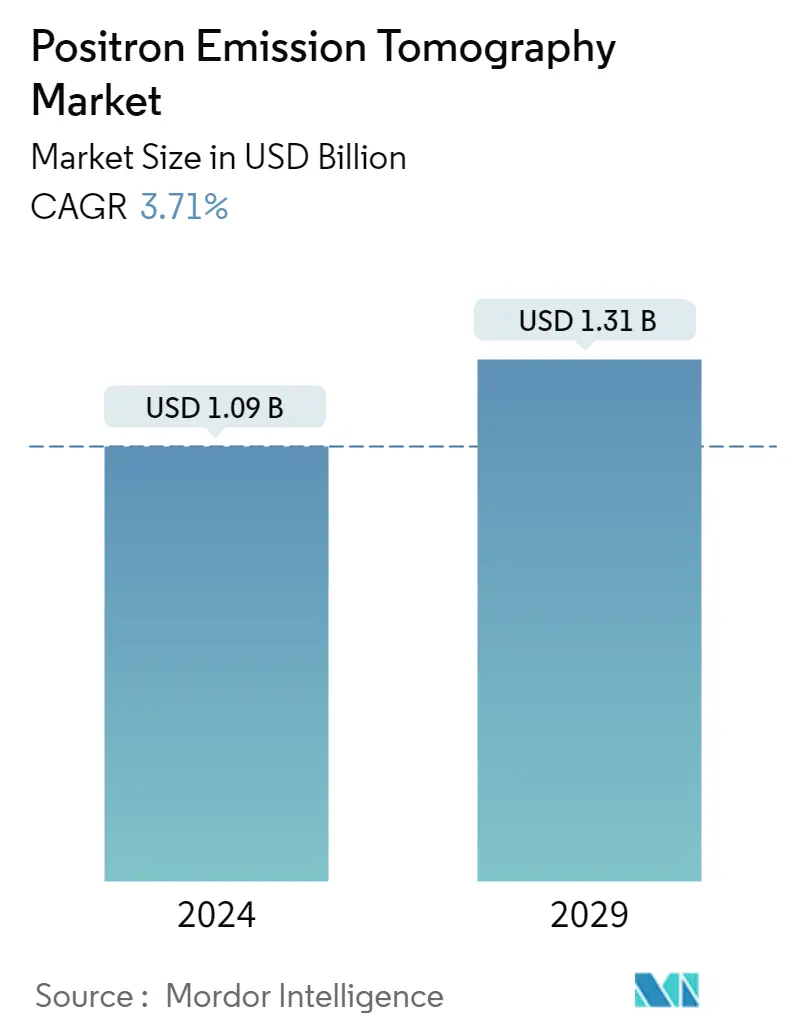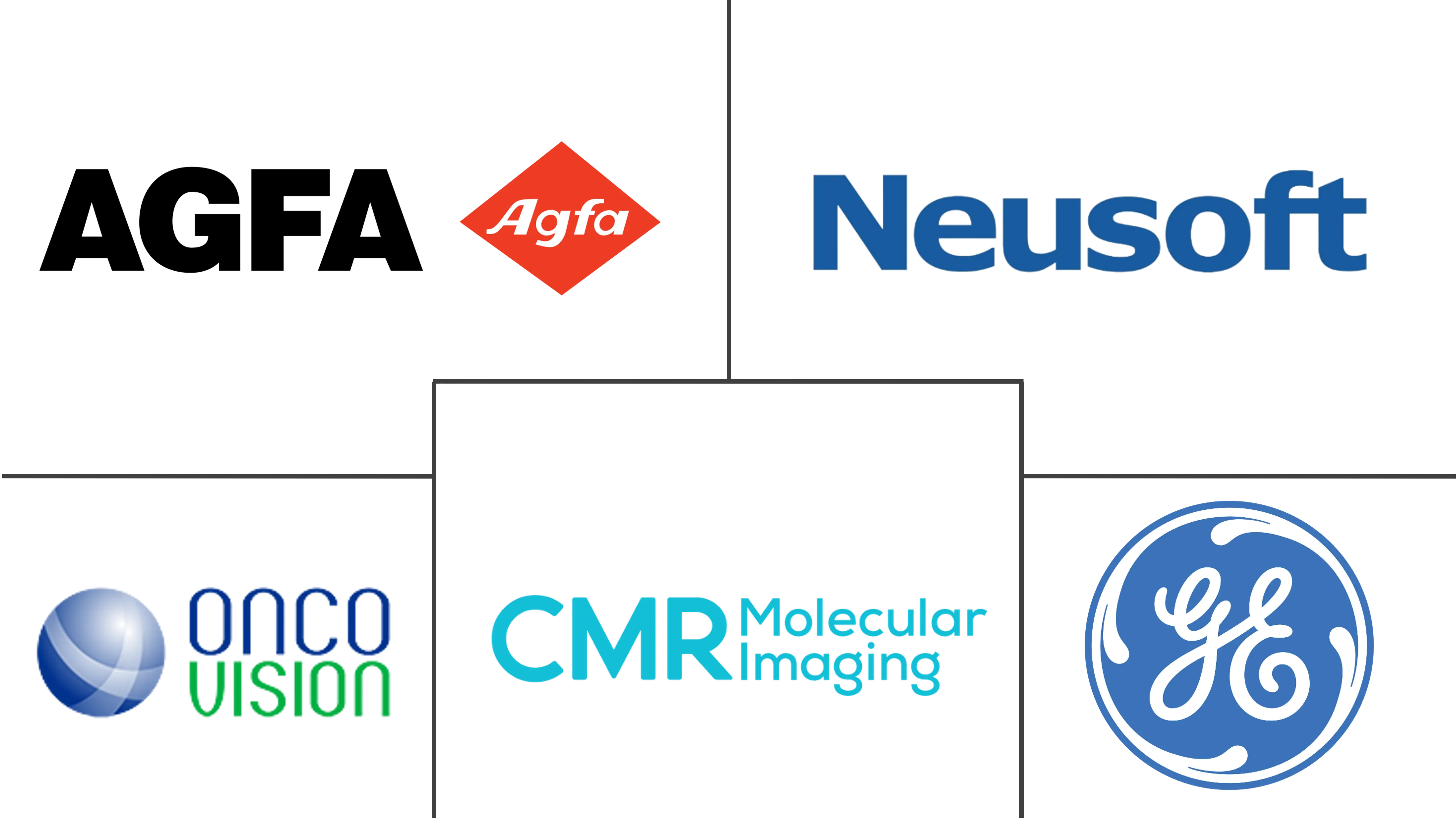Market Size of Positron Emission Tomography Industry

| Study Period | 2021 - 2029 |
| Market Size (2024) | USD 1.09 Billion |
| Market Size (2029) | USD 1.31 Billion |
| CAGR (2024 - 2029) | 3.71 % |
| Fastest Growing Market | Asia Pacific |
| Largest Market | North America |
Major Players
*Disclaimer: Major Players sorted in no particular order |
Need a report that reflects how COVID-19 has impacted this market and its growth?
Positron Emission Tomography (PET) Market Analysis
The Positron Emission Tomography Market size is estimated at USD 1.09 billion in 2024, and is expected to reach USD 1.31 billion by 2029, growing at a CAGR of 3.71% during the forecast period (2024-2029).
COVID-19 significantly affected the positron emission tomography market during the initial phases owing to the complete shutdown of radiological and scan services to reduce the spreading of the virus. Furthermore, due to the fear of the virus, people reduced their visits to scanning centers and clinics. According to research presented at the Society of Nuclear Medicine and Molecular Imaging (SNMMI) 2021 Annual Meeting, the effects of COVID-19 on the brain could be accurately measured with positron emission tomography (PET). Newly diagnosed COVID-19 patients, who required inpatient treatment and underwent PET brain scans, were found to have deficits in neuronal function and accompanying cognitive impairment. In some, this impairment continued for six months after diagnosis. With the role of PET during the COVID-19 pandemic being adequately explored, the paradigm is likely to be applied in combating various other epidemics in the future.
Some factors driving the market growth include the increasing demand for PET analysis in radiopharmaceuticals and the integration of X-ray tomography (CT) into PET. According to the World Nuclear Association April 2022 update, around 40 million nuclear medicine procedures are performed each year, and demand for radioisotopes is increasing by up to 5% annually. Over 10,000 hospitals worldwide use radioisotopes in medicine, and about 90% of the procedures are for diagnosis. As per the same source, in developed countries (about one-quarter of the world population), the frequency of diagnostic nuclear medicine is 1.9% per year, and the frequency of therapy with radioisotopes is about one-tenth. Also, in the United States, over 20 million nuclear medicine-related procedures are performed per year, and in Europe, about 10 million. In Australia, there are about 560,000 procedures performed per year, and of these, 470,000 are performed using reactor isotopes. The use of radiopharmaceuticals in diagnosis is growing at over 10% per year. PET evaluates organ and tissue functions using small amounts of radioactive materials known as radiotracers or radiopharmaceuticals, a special camera, and a computer. Hence, the rise in radiopharmaceutical analysis is likely to boost market growth over the forecast period.
Technological advancements like the introduction of Time of Flight (TOF) and the increasing popularity of hybrid imaging systems play an important role in the growth of the nuclear imaging market. For instance, in June 2022, researchers from the University of Oxford developed three DL-TOF models (based on U-Net convolutional neural networks) to transform non-TOF PET data into corresponding TOF-like images. The model employed different levels of TOF strength (low, medium, or high) to trade off contrast enhancement against noise reduction. Hence such innovations the in the field of PET are likely to boost the market growth over the forecast period. Moreover, the market players are focused on adopting partnership strategies to expand their product portfolios. For instance, in May 2021, GE Healthcare strengthened its PET imaging portfolio by acquiring Zionexa, a prominent innovator of in vivo oncology and neurology biomarkers that help enable more personalized healthcare.
Thus, due to the increasing demand for PET analysis in radiopharmaceuticals and technological advancements in PET imaging in oncology, the positron emission tomography market is expected to witness market growth over the forecast period. However, factors such as the shorter half-life of radioisotopes and stringent regulatory guidelines are expected to impede market growth in the near future.
